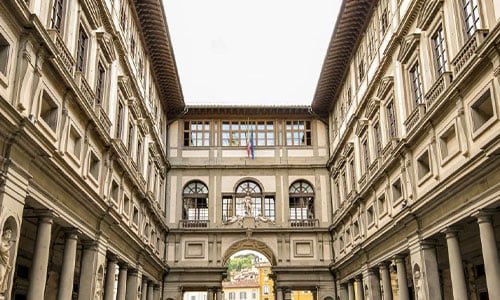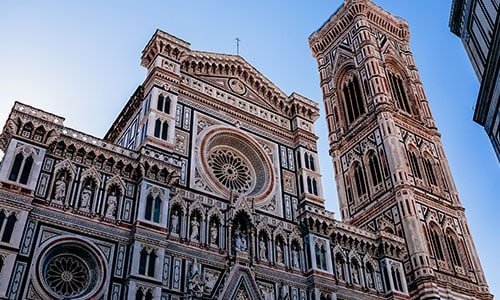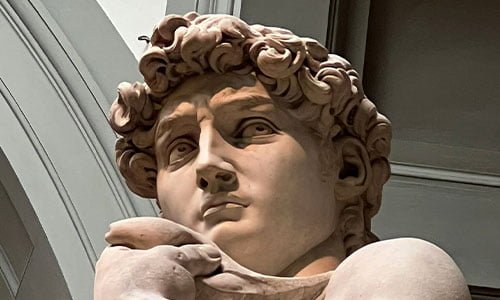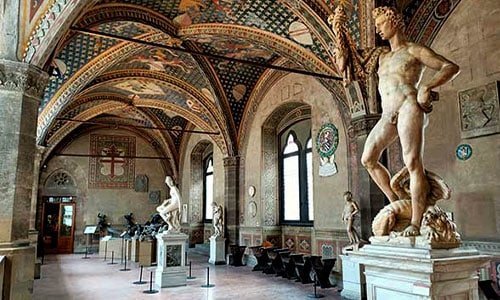piazzale michelangelo
Piazzale Michelangelo: The Magnificent Belvedere Over Florence, Designed by Giuseppe Poggi
History of Piazzale Michelangelo in Florence: The Birth of One of the World’s Top 10 Most Photographed Places
Piazzale Michelangelo is an iconic place in Florence, a must-visit for tourists who want to take in a panoramic view of the city center from above but not too far above—a close distance, one might say, choosing to use a daring linguistic oxymoron. Piazzale Michelangelo represents the classic vantage point from which to admire the magnificence of Florence, a concentrated masterpiece of art, yet with a unique breadth and location that sets it apart from any other belvedere in the world.
But when was Piazzale Michelangelo built? Did it exist in the Middle Ages? What was its original purpose? These are just a few questions we will answer in this in-depth article about one of Florence’s most famous landmarks. Follow along, as we are sure to surprise you.
On November 18, 1864, Florence became the capital of Italy. Immediately, the need arises to adapt a medieval and Renaissance city of modest dimensions to its new, important status and the significant role that awaits the city.
In the ancient urban fabric, for example, there was no distinction between public and private areas, even after the reforms of the House of Lorraine. Surrounded by 14th-century walls, the city had found a balance over the centuries between buildings and green areas, and now its inadequacy became evident with its new role.
Architect Giuseppe Poggi was entrusted with the project to adapt and expand Florence. Poggi was no ordinary architect; he was already widely known for combining the Neo-Renaissance style (which would be suitable for the city’s history) with the new trends associated primarily with English parks. The architect worked tirelessly and performed a true miracle, delivering the executive project in record time on February 18, 1865, just a few months after the city’s new designation was officialized.
The Ring Roads and the Viale dei Colli
The significant works began in May 1865 and were completed 5 years later, as the temporary capital was already nearing the end of its task.
Poggi completely transformed the city between the birth of new urban areas and the much-debated demolition of the historic walls. On “this side of the Arno,” new boulevards were built, known as the ring roads—a series of wide tree-lined streets encircling the city center, inspired by the boulevards of Paris. On the “other side of the Arno,” in the Oltrarno area, across the river, the Viale dei Colli came to life—a scenic road 8 kilometers long, with spacious green spaces on either side, adorned with luxurious villas symbolizing the city’s upper bourgeoisie. At its summit, the expansive and lengthy route was to be enhanced by a vast belvedere square and the entire avenue’s pride and joy.

Birth of Piazzale Michelangelo
Piazzale Michelangelo was built in 1869, at the peak of the Viale dei Colli, on a hill just south of the historic center. The Italian journalist Pietro Coccoluto Ferr described the square’s rapid construction in great detail.
Agni (known under the pseudonym Yorick) did not hesitate to report how some Florentines were disappointed “by the excessive expense” of its construction.
The square, dedicated to Michelangelo, still houses bronze copies of some famous works preserved in Florence: the David and the four allegories from the Medici Chapels in San Lorenzo. While the originals are in white marble, the copies are made of bronze. It is worth noting that the statue of David was carried to the top on June 25, 1873, by nine pairs of oxen.
The Neoclassical Loggia
Poggi also designed the neoclassical loggia that dominates the entire terrace and now houses a panoramic restaurant. Initially, it was intended to host a museum of Michelangelo’s works, but it was never realized. On the balcony’s wall beneath the loggia is an inscription in large letters commemorating Poggi’s work: “Giuseppe Poggi, Florentine architect, look around, here is his monument MCMXI.”
Moreover, only some know that between 1890 and 1935, the area hosted the tracks of the Chianti tramway, which connected Florence with San Casciano in Val di Pesa and Greve in Chianti.
The Line 13 Tram that Crossed Florence
In the past, Piazzale Michelangelo represented an essential hub of Florence’s tramway network, which was completely dismantled by 1958. It was traversed by Line 13, which, since the early 1900s, ran from Piazza del Duomo, along Ponte alle Grazie and Piazza Ferrucci, onto Viale Michelangelo, terminating at Via del Gelsomino, where a tram depot was located.
In 1927, Line 13 became a circular route called Linea 13 Nero, with a passage from Piazza Duomo, Piazzale Michelangelo, Porta Romana, and back to Piazza Duomo. The reverse circular route was referred to as Linea 13 Rosso.
What Can You See from Piazzale Michelangelo?
You can easily reach Piazzale Michelangelo, which sits 104 meters above sea level, by taking Viale Michelangelo (or, from the opposite side, Viale Galileo) or Viale Giuseppe Poggi. There is another, more “romantic” way to reach Piazzale Michelangelo—by climbing the monumental staircases known as the Rampe del Poggi on foot, starting from Piazza Poggi in the San Niccolò neighborhood.
The panorama you can enjoy is breathtaking, ranging from Forte Belvedere to Santa Croce, passing through the banks of the Arno River, and the enchanting sequence of Florence’s bridges. Among the architectural wonders, you’ll spot the Duomo, Giotto’s Campanile, Palazzo Vecchio, the Bargello, the National Library, and the octagonal bell tower of the Badia Fiorentina, not to mention the hills to the north of the city, with Fiesole and Settignano at the center.
watch below videos about Florence piazzale michelangelo
question and Answers about piazzale michelangelo
how to get to piazzale michelangelo?
Finding out how to get to Piazzale Michelangelo might get confusing. From the Florence city center, you can reach the square by foot, public transport, or even a car. However, if it’s in your power, we strongly recommend walking to make the most of the experience.
how to get to piazzale michelangelo by bus?
To get to Piazzale Michelangelo by bus from Florence city center, you can take bus no: 12 or 13. you can get more details about bus routes in Florence on the Moovit website.
how to get to piazzale michelangelo from Florence?
To reach Piazzale Michelangelo, you have two bus options: the 12 bus (Piazzale Michelangelo) or the 13 bus (Il David). However, from the main tourist area in Florence, there are no convenient stops for these buses except for the Santa Maria Novella train station. During weekdays, three buses of each route operate every hour, while on weekends and holidays, there are typically two buses per hour.
Please note that the frequency reduces to one bus per hour after 10 p.m. These numbers double if you can take the 12 or 13 bus. Bus service begins around 6 a.m., and the last bus usually departs from Piazzale Michelangelo around 12:30 a.m.
The Santa Maria Novella train station bus stop is outside the main entrance. If you are facing the main entrance, it is located at the far left where the building ends. If you exit the train station and have it behind you, the bus stop will be on your right. The name of the bus stop is Stazione Paracheggio.
is piazzale michelangelo free?
Yes. The entire area is free to visit. Piazzale Michelangelo is one of the best free places to visit in Florence around sunset.






